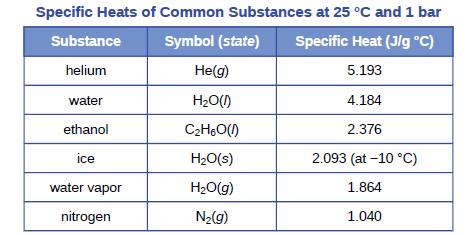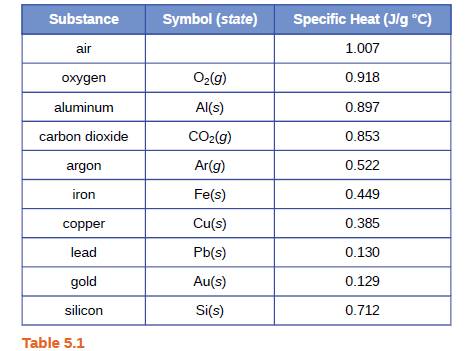
Chemistry by OpenStax (2015-05-04)
1st Edition
ISBN: 9781938168390
Author: Klaus Theopold, Richard H Langley, Paul Flowers, William R. Robinson, Mark Blaser
Publisher: OpenStax
expand_more
expand_more
format_list_bulleted
Textbook Question
Chapter 5, Problem 10E
A piece of unknown substance weighs 44.7 g and requires 2110 J to increase its temperature from 23.2 °C to 89.6 °C.
(a) What is the specific heat of the substance?
(b) If it is one of the substances found in Table 5.1, what is its likely identity?


Expert Solution & Answer
Trending nowThis is a popular solution!

Students have asked these similar questions
Questions 4 and 5
For a titration of 40.00 mL of 0.0500 M oxalic acid H2C2O4 with 0.1000 M KOH, calculate the pH at each of the following volume of KOH used in the titration: 1) before the titration begin;2) 15 mL; 3) 20 mL; 4) 25 mL; 5) 40 mL; 6) 50 mL. Ka1 = 5.90×10^-2, Ka2 = 6.50×10^-5 for oxalic acid.
Predict the major organic product(s), if any, of the following reactions. Assume all reagents are in excess unless otherwise indicated.
Chapter 5 Solutions
Chemistry by OpenStax (2015-05-04)
Ch. 5 - A burning match and a bonfire may have the same...Ch. 5 - Prepare a table identifying several energy...Ch. 5 - Explain the difference between heat capacity and...Ch. 5 - Calculate the heat capacity, in joules and in...Ch. 5 - Calculate the heat capacity, in joules and in...Ch. 5 - How much heat, in joules and in calories, must be...Ch. 5 - How much heat, in joules and in calories, is...Ch. 5 - How much would the temperature of 275 g of water...Ch. 5 - If 14.5 kJ of heat were added to 485 g of liquid...Ch. 5 - A piece of unknown substance weighs 44.7 g and...
Ch. 5 - A piece of unknown solid substance weighs 437.2 g,...Ch. 5 - An aluminum kettle weighs 1.05 kg. (a) What is the...Ch. 5 - Most people find waterbeds uncomfortable unless...Ch. 5 - A 500-mL bottle of water at room temperature and a...Ch. 5 - Would the amount of heat measured for the reaction...Ch. 5 - Would the amount of heat absorbed by the...Ch. 5 - Would the amount of heat absorbed by the...Ch. 5 - How many milliliters of water at 23 C with a...Ch. 5 - How much will the temperature of a cup (180 g) of...Ch. 5 - A 45-g aluminum spoon (specific heat 0.88 J/g C)...Ch. 5 - The temperature of the cooling water as it leaves...Ch. 5 - A 70.0-g piece of metal at 80.0 °C is placed in...Ch. 5 - If a reaction produces 1.506 kJ of heat, which is...Ch. 5 - A 0.500-g sample of KCl is added to 50.0 g of...Ch. 5 - Dissolving 3.0 g of CaCl2(s) in 150.0 g of water...Ch. 5 - When 50.0 g of 0.200 M NaCl(aq) at 24.1 C is added...Ch. 5 - The addition of 3.15 g of Ba(OH)28H2O to a...Ch. 5 - The reaction of 50 mL of acid and 50 mL of base...Ch. 5 - If the 3.21 g of NH4NO3 in Example 5.6 were...Ch. 5 - When 1.0 g of fructose, C6H12O6(s), a sugar...Ch. 5 - When a 0.740-g sample of trinitrotoluene (TNT),...Ch. 5 - One method of generating electricity is by burning...Ch. 5 - The amount of fat recommended for someone with a...Ch. 5 - A teaspoon of the carbohydrate sucrose (common...Ch. 5 - What is the maximum mass of carbohydrate in a 6-oz...Ch. 5 - A pint of premium ice cream can contain 1100...Ch. 5 - A serving of a breakfast cereal contains 3 g of...Ch. 5 - Which is the least expensive source of energy in...Ch. 5 - Explain how the heat measured in Example 5.5...Ch. 5 - Using the data in the check your learning section...Ch. 5 - Calculate the enthalpy of solution ( H for the...Ch. 5 - Calculate H for the reaction described by the...Ch. 5 - Calculate the enthalpy of solution ( H for the...Ch. 5 - Although the gas used in an oxyacetylene torch...Ch. 5 - How much heat is produced by burning 4.00 moles of...Ch. 5 - How much heat is produced by combustion of 125 g...Ch. 5 - How many moles of isooctane must be burned to...Ch. 5 - What mass of carbon monoxide must be burned to...Ch. 5 - When 2.50 g of methane burns in oxygen, 125 kJ of...Ch. 5 - How much heat is produced when loo mL of 0.250 M...Ch. 5 - A sample of 0.562 g of carbon is burned in oxygen...Ch. 5 - Before the introduction of chlorofluorocarbons,...Ch. 5 - Homes may be heated by pumping hot water through...Ch. 5 - Which of the enthalpies of combustion in Table 5.2...Ch. 5 - Does the standard enthalpy of formation of H2O(g)...Ch. 5 - Joseph Priestly prepared oxygen in 1774 by heating...Ch. 5 - How many kilojoules of heat will be released when...Ch. 5 - How many kilojoules of heat will be released when...Ch. 5 - The following sequence of reactions occurs in the...Ch. 5 - Both graphite and diamond burn....Ch. 5 - From the molar heats of formation in Appendix G,...Ch. 5 - Which produces more heat?...Ch. 5 - Calculate H298 for the process...Ch. 5 - Calculate H298 for the process...Ch. 5 - Calculate H for the process Hg2Cl2(s)2Hg(l)+Cl2(g)...Ch. 5 - Calculate H298 for the process...Ch. 5 - Calculate the standard molar enthalpy of formation...Ch. 5 - Using the data in Appendix G, calculate the...Ch. 5 - Using the data in Appendix G, calculate the...Ch. 5 - The following reactions can be used to prepare...Ch. 5 - The decomposition of hydrogen peroxide, H2O2, has...Ch. 5 - Calculate the enthalpy of combustion of propane,...Ch. 5 - Calculate the enthalpy of combustion of butane,...Ch. 5 - Both propane and butane are used as gaseous fuels....Ch. 5 - The white pigment TiO2 is prepared by the reaction...Ch. 5 - Water gas, a mixture of H2 and CO, is an important...Ch. 5 - In the early days of automobiles, illumination at...Ch. 5 - From the data in Table 5.2, determine which of the...Ch. 5 - The enthalpy of combustion of hard coal averages...Ch. 5 - Ethanol, C2H5OH, is used as a fuel for motor...Ch. 5 - Among the substances that react with oxygen and...Ch. 5 - How much heat is produced when 1.25 g of chromium...Ch. 5 - Ethylene, C2H2, a byproduct from the fractional...Ch. 5 - The oxidation of the sugar glucose, C6H12O6, is...Ch. 5 - Propane, C3H8, is a hydrocarbon that is commonly...Ch. 5 - During a recent winter month in Sheboygan,...
Additional Science Textbook Solutions
Find more solutions based on key concepts
Which of the following statements about the general functions of the nervous system is false?
The three primary...
Human Anatomy & Physiology (2nd Edition)
What two components contribute to species diversity? Explain how two communities with the same number of specie...
Campbell Biology (11th Edition)
Match the following examples of mutagens. Column A Column B ___a. A mutagen that is incorporated into DNA in pl...
Microbiology: An Introduction
29. Consider the unbalanced equation for the reaction of solid lead with silver nitrate:
a. Balance the equati...
Introductory Chemistry (6th Edition)
Distinguish between microevolution, speciation, and macroevolution.
Campbell Essential Biology (7th Edition)
17. Anthropologists are interested in locating areas in Africa where fossils 4-8 million years old might be fou...
Campbell Biology: Concepts & Connections (9th Edition)
Knowledge Booster
Learn more about
Need a deep-dive on the concept behind this application? Look no further. Learn more about this topic, chemistry and related others by exploring similar questions and additional content below.Similar questions
- Predict the major organic product(s), if any, of the following reactions. Assume all reagents are in excess unless otherwise indicated.arrow_forwardHow many signals would you expect to find in the 1 H NMR spectrum of each given compound? Part 1 of 2 2 Part 2 of 2 HO 5 ☑ Х IIIIII***** §arrow_forwardA carbonyl compound has a molecular ion with a m/z of 86. The mass spectra of this compound also has a base peak with a m/z of 57. Draw the correct structure of this molecule. Drawingarrow_forward
- Can you draw this using Lewis dot structures and full structures in the same way they are so that I can better visualize them and then determine resonance?arrow_forwardSynthesize the following compound from cyclohexanol, ethanol, and any other needed reagentsarrow_forwardFor a titration of 20.00 mL of 0.0500 M H2SO4 with 0.100 M KOH, calculate the pH at each of the following volume of KOH used in the titration: 1) before the titration begin; 2) 10.00 mL; 3) 20.00 mL; 4) 30.00 mL. Ka2 = 1.20×10-2 for H2SO4.arrow_forward
- Curved arrows are used to illustrate the flow of electrons. Using the provided starting and product structures, draw the curved electron-pushing arrows for the following reaction or mechanistic step(s) Be sure to account for all bond-breaking and bond-making steps Problem 73 of 10 Drawing Amows ro HO Donearrow_forward12. Synthesize the following target molecules (TMs) using the specified starting materials. .CI a) HO3S SM TM b) HO- SMarrow_forwardFor a titration of 20.00 mL of 0.0500 M H2SO4 with 0.100 M KOH, calculate the pH at each of the following volume of KOH used in the titration: 1) before the titration begin; 2) 10.00 mL; 3) 20.00 mL; 4) 30.00 mL. Ka2 = 1.20×10-2 for H2SO4.arrow_forward
- Write the systematic name of each organic molecule: structure name show work. don't give Ai generated solutionarrow_forwardShow work with explanation needed. Don't give Ai generated solutionarrow_forwardA Elschboard Part of SpeechT-D Alt Leaming App app.aktiv.com Curved arrows are used to illustrate the flow of electrons. Using the provided resonance structures, draw the curved electron- pushing arrows to show the interconversion between resonance hybrid contributors. Be sure to account for all bond-breaking and bond-making steps. Include all lone pairs and formal charges in the structures. Problem 45 of 10 I Select to Add Arrows N Please selarrow_forward
arrow_back_ios
SEE MORE QUESTIONS
arrow_forward_ios
Recommended textbooks for you
 General Chemistry - Standalone book (MindTap Cour...ChemistryISBN:9781305580343Author:Steven D. Gammon, Ebbing, Darrell Ebbing, Steven D., Darrell; Gammon, Darrell Ebbing; Steven D. Gammon, Darrell D.; Gammon, Ebbing; Steven D. Gammon; DarrellPublisher:Cengage Learning
General Chemistry - Standalone book (MindTap Cour...ChemistryISBN:9781305580343Author:Steven D. Gammon, Ebbing, Darrell Ebbing, Steven D., Darrell; Gammon, Darrell Ebbing; Steven D. Gammon, Darrell D.; Gammon, Ebbing; Steven D. Gammon; DarrellPublisher:Cengage Learning Chemistry: Principles and ReactionsChemistryISBN:9781305079373Author:William L. Masterton, Cecile N. HurleyPublisher:Cengage Learning
Chemistry: Principles and ReactionsChemistryISBN:9781305079373Author:William L. Masterton, Cecile N. HurleyPublisher:Cengage Learning Chemistry: The Molecular ScienceChemistryISBN:9781285199047Author:John W. Moore, Conrad L. StanitskiPublisher:Cengage Learning
Chemistry: The Molecular ScienceChemistryISBN:9781285199047Author:John W. Moore, Conrad L. StanitskiPublisher:Cengage Learning Chemistry by OpenStax (2015-05-04)ChemistryISBN:9781938168390Author:Klaus Theopold, Richard H Langley, Paul Flowers, William R. Robinson, Mark BlaserPublisher:OpenStax
Chemistry by OpenStax (2015-05-04)ChemistryISBN:9781938168390Author:Klaus Theopold, Richard H Langley, Paul Flowers, William R. Robinson, Mark BlaserPublisher:OpenStax Chemistry: Principles and PracticeChemistryISBN:9780534420123Author:Daniel L. Reger, Scott R. Goode, David W. Ball, Edward MercerPublisher:Cengage LearningChemistry: Matter and ChangeChemistryISBN:9780078746376Author:Dinah Zike, Laurel Dingrando, Nicholas Hainen, Cheryl WistromPublisher:Glencoe/McGraw-Hill School Pub Co
Chemistry: Principles and PracticeChemistryISBN:9780534420123Author:Daniel L. Reger, Scott R. Goode, David W. Ball, Edward MercerPublisher:Cengage LearningChemistry: Matter and ChangeChemistryISBN:9780078746376Author:Dinah Zike, Laurel Dingrando, Nicholas Hainen, Cheryl WistromPublisher:Glencoe/McGraw-Hill School Pub Co

General Chemistry - Standalone book (MindTap Cour...
Chemistry
ISBN:9781305580343
Author:Steven D. Gammon, Ebbing, Darrell Ebbing, Steven D., Darrell; Gammon, Darrell Ebbing; Steven D. Gammon, Darrell D.; Gammon, Ebbing; Steven D. Gammon; Darrell
Publisher:Cengage Learning

Chemistry: Principles and Reactions
Chemistry
ISBN:9781305079373
Author:William L. Masterton, Cecile N. Hurley
Publisher:Cengage Learning

Chemistry: The Molecular Science
Chemistry
ISBN:9781285199047
Author:John W. Moore, Conrad L. Stanitski
Publisher:Cengage Learning

Chemistry by OpenStax (2015-05-04)
Chemistry
ISBN:9781938168390
Author:Klaus Theopold, Richard H Langley, Paul Flowers, William R. Robinson, Mark Blaser
Publisher:OpenStax

Chemistry: Principles and Practice
Chemistry
ISBN:9780534420123
Author:Daniel L. Reger, Scott R. Goode, David W. Ball, Edward Mercer
Publisher:Cengage Learning

Chemistry: Matter and Change
Chemistry
ISBN:9780078746376
Author:Dinah Zike, Laurel Dingrando, Nicholas Hainen, Cheryl Wistrom
Publisher:Glencoe/McGraw-Hill School Pub Co
The Laws of Thermodynamics, Entropy, and Gibbs Free Energy; Author: Professor Dave Explains;https://www.youtube.com/watch?v=8N1BxHgsoOw;License: Standard YouTube License, CC-BY